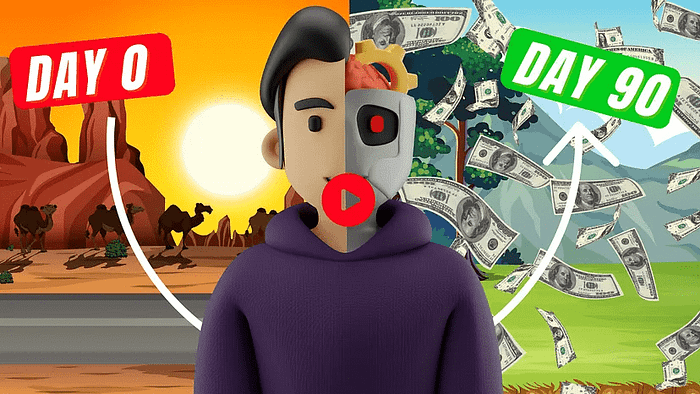How AI Predictive Analytics Can Increase Your Ad ROI by 5X
AI predictive analytics 5X ROI has transformed the landscape of digital marketing, offering unprecedented opportunities for businesses to maximize their advertising investments.
Many marketers struggle daily with underperforming Facebook ads while so-called experts flood feeds with promises of quick success tactics that rarely deliver meaningful results.
The truth is there’s no magical solution – successful advertising requires precise adjustments and strategic improvements based on data-driven insights.
Unfortunately, many advertisers continue making the same mistakes, unaware of how dramatically Facebook marketing has evolved with AI technology.
It’s essential to reconsider your approach to ad campaigns by leveraging AI as your strategic advantage in today’s competitive marketplace.
Imagine implementing an advertising strategy that continuously adapts, learns from performance data, and automatically focuses resources on ads that genuinely deliver results.
This comprehensive guide will demonstrate exactly how to gather the right data and harness AI-powered tools to dramatically improve your ad performance and achieve that coveted 5X return on investment.
We strongly recommend that you check out our guide on how to take advantage of AI in today’s passive income economy.
Table of Contents
Step 1: Gathering Critical Facebook Ads Data
Launching Facebook ad after Facebook ad without understanding what’s not working leads to frustration and wasted budgets that could be allocated more effectively with proper analysis.
While you might speculate based on competitors’ strategies, this provides limited insight compared to leveraging your own campaign data for making informed decisions.
Gathering comprehensive information from your Facebook ads platform is crucial for understanding performance metrics and implementing data-driven optimization rather than relying on guesswork.
Downloading these analytics files is straightforward, with options to export as CSV format for direct management and manipulation in Excel or other spreadsheet applications.
To access this valuable data, navigate to Ads Manager and locate the “Ad Reports” option in the left sidebar menu where you’ll find extensive reporting capabilities.
Click on the “Reports and Exports” tab which appears on the left side of your screen, then select “Exports” where you’ll be prompted to specify which report types you need to analyze.
Before completing this step, you’ll need to create a custom report by returning to the “Reports” section and selecting “Create Report” to establish your specific parameters and filters.
This allows you to customize exactly what information you want to analyze by selecting options like pivot table, trend line chart, or bar chart to visualize your campaign performance effectively.
After choosing your preferred report format, you can further customize by selecting specific metrics on the right panel, making sure to include campaign names, ad set names, and individual ad names for comprehensive analysis.
Remember to establish an appropriate date range to provide valuable context for identifying long-term performance trends rather than focusing on isolated metrics.
Once you’ve saved your customized report, return to “All Reports” where you’ll now see your newly created report available as an export option for detailed analysis.
Having this organized data framework establishes the foundation for implementing AI predictive analytics to transform raw numbers into actionable insights that can dramatically improve your advertising ROI.
Step 2: Leveraging AI-Powered Analysis Tools
Data analysis often presents a significant challenge – you’ve gathered extensive metrics, but extracting meaningful insights requires specialized knowledge that AI can now provide.
Many marketers encounter discussions about “useful analytics” without practical guidance on implementation, creating a knowledge gap that AI-powered marketing analytics tools can effectively bridge.
For those already comfortable with data interpretation, your skills give you an advantage, but for everyone else, AI serves as both teacher and interpreter, translating complex metrics into actionable recommendations.
Now that you’ve established your customized reports, it’s time to export them by clicking “Export” and downloading the files in your preferred format – options typically include CSV, PDF, or PNG.
While downloading as an Excel file provides flexibility for personal records and manipulation, PDF format often works best when inputting into AI tools for analysis purposes.
With your exported data ready, navigate to powerful AI platforms like ChatGPT or Google Gemini where you can attach your files for comprehensive analysis and interpretation.
Try using this specific prompt to maximize the AI’s analytical capabilities: “Analyze this Facebook ads data. Identify top-performing ad sets, underperforming campaigns, and potential optimization strategies. Provide insights into audience demographics, ad creative effectiveness, and overall campaign performance.”
This targeted instruction effectively transforms the AI into your personal Facebook ads consultant, delivering expert-level analysis without requiring specialized technical knowledge.
You can continuously refine your prompts to address specific concerns like age and gender variations, identify problematic patterns, or generate creative optimization strategies tailored to your campaign objectives.
Another effective approach is transforming the AI into your personal advertising instructor with alternative prompts like: “Provide me with a sample Meta Ads Manager data set. Explain the different data types and how to visualize them. Present me with a problem in this data set and guide me through the process of interpreting the data, identifying patterns, and drawing conclusions.”
Even with simpler demonstrations, AI tools can effectively break down complex categories and demonstrate methods for summarizing and interpreting the data you receive.
What would be even more valuable is implementing a system that could automatically identify negative performance patterns and remove underperforming ads without requiring constant manual intervention – fortunately, this capability exists through AI campaign optimization techniques that we’ll explore next.
Step 3: Utilizing Automated Rules for Optimization
The ability to automatically manage ad performance while you focus on other priorities isn’t just a fantasy – it’s achievable through automated rules powered by AI predictive analytics.
Automated rules provide a sophisticated framework to streamline your ad management process and continuously optimize performance based on predetermined criteria you establish.
With this AI-driven advertising approach, you can automate critical tasks including pausing underperforming ads, increasing budgets for high-performing campaigns, and receiving customized performance notifications.
This automation saves significant time while ensuring your advertising budget is consistently allocated to the most effective campaigns without requiring constant manual monitoring and adjustment.
Setting up these automated rules is straightforward – begin by logging into your Facebook Ads Manager account and navigating to the “Tools” section located in the left sidebar menu.
From the tools menu, locate and select “Create Rule” which will prompt you to name your automation – consider using descriptive names like “Ad Stop” if your goal is automatically pausing underperforming advertisements.
Next, define the specific conditions that will trigger your rule, such as when cost per result exceeds a certain threshold or when a specific performance metric reaches a predetermined value.
You’ll then specify the time frame for evaluating these conditions and select the action to be taken when your criteria are met, such as pausing ad sets, adjusting budgets, or sending performance notifications.
When implementing automated rules, regularly monitor their performance to ensure they’re functioning as intended and delivering the expected results over time.
Be specific with your conditions and actions to maximize effectiveness – vague parameters will produce inconsistent results that may not align with your campaign objectives.
Experiment with different rule combinations to discover optimal settings for your specific campaigns, but avoid overcomplicated structures that might create confusion or conflicting actions.
Keep your rules simple and focused on key performance indicators that directly impact your business goals and return on investment metrics for maximum effectiveness.
Automated rules exemplify the principle of working smarter rather than harder, allowing you to react faster to market changes and improve results without constant manual intervention.
This AI-driven approach represents a significant evolution from traditional marketing methods, enabling continuous optimization based on performance data rather than intuition alone.
The system actively learns from campaign performance to make increasingly effective decisions about resource allocation and targeting adjustments over time.
By implementing automated rules, you establish a framework for continuous improvement that operates efficiently even when you’re focused on other aspects of your business.
Step 4: Exploring Advanced AI Tools for Meta Advertising
Beyond basic automated rules, Meta has integrated sophisticated AI capabilities throughout their advertising platform, creating unprecedented opportunities for campaign optimization.
AI-powered automated insights provide comprehensive performance analysis, ad campaign recommendations, and data-driven optimization suggestions that continuously improve based on real-world results.
Another powerful innovation is Dynamic Ads – an AI-fueled advertising system that automatically places your promotions across Meta’s platforms in the path of users whose interests align with your products and services.
This system identifies potential customers based on their browsing history, search queries, engagement patterns, and previous interactions to deliver highly targeted advertising experiences.
Dynamic Ads analyzes user interest signals and matches them with relevant products from your catalog, presenting them to prospective customers most likely to convert based on behavioral patterns.
Additionally, this AI system helps create personalized calls-to-action, compelling descriptions, and optimized images that resonate with specific audience segments for maximum effectiveness.
To implement Dynamic Ads, you’ll need several prerequisites: a Facebook Business Manager account, a product catalog established in Facebook Commerce Manager, and an active Facebook Ads Manager account.
Once these elements are in place, implementation follows a straightforward process beginning in Facebook Ads Manager where you’ll create a new campaign with conversions or catalog sales as your objective.
After selecting Dynamic Ads as your ad type, you’ll configure various settings including preferred ad formats such as single image, carousel, or collection depending on your product presentation needs.
Next, establish your targeting parameters including interests, behaviors, and demographics along with your budget allocation and bidding strategy for campaign delivery.
Choose appropriate optimization goals such as conversions or clicks depending on your business objectives and campaign purpose for maximum effectiveness.
Connect your product catalog by selecting the specific collection you want to promote and choosing which product sets or individual items to feature in your dynamic advertising campaign.
When customizing your creative elements, upload high-quality default images or utilize product images directly from your catalog for consistent brand presentation.
Craft compelling headlines and descriptions that communicate your value proposition effectively, utilizing AI-generated recommendations or creating custom messaging aligned with your brand voice.
After reviewing all settings and previewing your campaign elements, you’re ready to launch your AI-optimized dynamic advertising campaign for maximum reach and effectiveness.
This integrated approach creates a sophisticated advertising strategy that manages complex elements automatically, delivering personalized experiences to prospective customers without requiring constant manual adjustments.
Enhancing Ad Creation with AI Tools
When establishing or rebranding your business, creating compelling visual assets can seem overwhelming without specialized design skills or extensive resources.
While AI image generators cannot fully replace professional designers, they provide excellent starting points for inspiration, creating high-quality visuals, and saving significant time on repetitive content creation tasks.
Tools like ChatGPT and Google Gemini serve as valuable editing partners when drafting copy for your website, social media posts, and advertising campaigns across platforms.
Try prompts like “Write five Instagram ad headlines for a new sustainable fashion brand targeting eco-conscious consumers” to generate creative starting points for your marketing materials.
If you’ve drafted content for your website but need refinement, paste it into these AI tools and request specific improvements such as making concise edits, suggesting alternative phrasing, or restructuring awkward passages.
Always remember to thoroughly proofread and fact-check all AI-generated content before publication, and never input sensitive personal or financial information into these platforms for security reasons.
While AI models continue becoming increasingly sophisticated, they can still make errors when addressing complex topics or specialized knowledge areas that require human verification.
Before implementing AI-generated messaging, consider how to differentiate your brand from competitors to avoid creating similar content that fails to highlight your unique value proposition.
Rather than manually reviewing competitor feedback, leverage AI to identify common pain points by analyzing their public reviews and highlighting recurring issues or dissatisfaction areas.
Visit your competitor’s Google review page, copy the URL, and ask your AI tool to “analyze these reviews, highlight all common issues and pain points” followed by the link for instant competitive intelligence.
Follow up by requesting “create five ad headlines for your brand that show a superior alternative” to generate messaging that specifically addresses identified weaknesses in competing offerings.
This approach not only streamlines content creation but also enhances effectiveness by emphasizing how your brand positively differentiates from competition in meaningful ways.
Real-World Impact of AI-Driven Marketing
While specific case studies of AI implementation remain somewhat limited in public discussion, the potential benefits and adoption rates of these AI-driven advertising techniques continue accelerating across industries.
A recent McKinsey survey indicates that organizations are increasingly implementing AI across business functions, with marketing, sales, and product development leading adoption rates compared to previous years.
In fact, marketing and sales departments represent one of four functional groups projected to capture approximately 95% of the estimated $4.4 trillion annual global productivity that generative AI could potentially contribute.
Browsing through community forums on platforms like Shopify and Reddit reveals growing conversations about practical AI applications for business optimization and marketing enhancement.
Forum participants regularly discuss using AI tools like ChatGPT for refining social media content, creating multilingual translations, and improving customer response systems to enhance overall marketing effectiveness.
Other discussions highlight innovative implementations like attaching AI-generated review summaries to product detail pages, creating more informative shopping experiences that boost conversion rates.
These real-world applications demonstrate that AI-powered marketing analytics and optimization tools aren’t just theoretical concepts but practical solutions being actively implemented by forward-thinking businesses.
As AI technology continues evolving and becoming more accessible, adoption rates will likely accelerate, making familiarity with these tools increasingly valuable for maintaining competitive advantage.
Conclusion
Implementing AI predictive analytics for your advertising campaigns represents a significant opportunity to dramatically improve performance metrics and achieve that coveted 5X ROI improvement.
By gathering comprehensive campaign data, leveraging AI for advanced analysis, implementing automated rules, and utilizing specialized AI tools like Dynamic Ads, you establish a framework for continuous optimization.
These integrated approaches allow you to create sophisticated advertising strategies that automatically adapt to performance data without requiring constant manual intervention or specialized technical knowledge.
The combination of artificial intelligence with human creativity and strategic thinking creates a powerful synergy that maximizes advertising effectiveness while minimizing wasted resources.
As AI technology continues advancing, those who embrace these tools early will gain significant competitive advantages through improved efficiency, better targeting, and higher conversion rates.
The future of digital advertising clearly belongs to those who effectively leverage AI-driven insights to inform their creative and strategic decisions rather than relying solely on intuition or outdated methodologies.
Start implementing these AI predictive analytics techniques today to transform your advertising performance and experience the dramatic ROI improvements they can deliver for your business.
Stay informed about emerging AI marketing tools and continuously experiment with new approaches to maintain your competitive edge in the rapidly evolving digital advertising landscape.

We strongly recommend that you check out our guide on how to take advantage of AI in today’s passive income economy.




